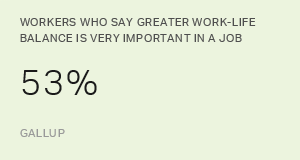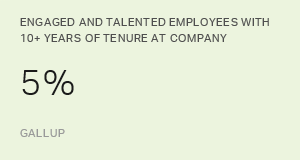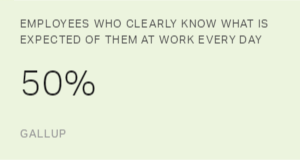Answering emails from the cheering section of a child's sporting event. Reviewing a team project from the comfort of a coffee shop. Moving work hours to earlier in the day to fit in an appointment late in the afternoon. Modern employees want professional success -- but not at the exclusion of autonomy and flexibility.
This is all the more true with the rise of technology and digitization. Many employees feel as though they are "always on," like their lives are fully integrated with their work. In a tech-driven world, work-life balance is essential to many employees.
Gallup analytics reveal that 53% of employees say greater work-life balance and personal well-being are "very important" to them when considering whether to take a job with a different organization (only topped by the ability to do what they do best). Flexibility is key to establishing the balance and well-being that employees are looking for, so it's not surprising that flexibility in time and location are among the top perks employees would change jobs for.
There isn't much debate about the value of offering flexibility. Flexibility, such as that offered through remote working, can attract and retain top talent, deepen employees' connections to their organization and reduce real estate costs. Having a flexible workplace can also help to improve employees' productivity and performance, attitudes and satisfaction, engagement and well-being, innovation and creativity, stress and burnout, absenteeism, and work-family conflict.
Flexibility fosters self-empowerment among employees, making them feel as though they work with you, not for you.
So why don't all organizations embrace flexibility? One reason (among others) is that not all job types, industries and work cultures lend themselves well to traditional flexibility offerings, such as work-from-home opportunities or work schedules that differ from employee to employee. However, flexibility is not a cookie-cutter, one-size-fits-all job benefit.
To infuse flexibility in various roles and cultures, leaders should rethink how and where to offer flexibility-related perks. Here are a few considerations that organizations should keep in mind.
Flexibility in the Nature and Type of Work
When employers cannot offer flexibility in "when" and "where" an employee can work, they should explore the possibility of flexibility in "what" type of work is done. Allowing an employee to identify their preferred type of work provides a sense of autonomy and promotes innovation, adaptability, communication and diversity of skills. And, having employees select their projects can spike their motivation.
Another option is job swapping, which permits employees to exchange responsibilities for a brief time. Geographic job swapping (having an employee rotate between locations or offices) is a twist on allowing flexibility in where an employee works. This tactic allows employees to experience new roles and office dynamics and meet new colleagues.
Some organizations also encourage employees to participate in workplace committees that aim to improve well-being, performance or quality. This practice gives employees a platform for sharing their opinions and improving their work environment. It also affords team members the opportunity to participate in decision-making processes.
Flexible Organizational Structure
Compared with a traditional organizational structure with a defined and sometimes strict leadership hierarchy, a lattice organizational structure with increased accessibility among employees, managers and leaders can foster an atmosphere of flexibility and autonomy. Employees have greater freedom to collaborate and share ideas when they are part of an informal work environment with fewer hierarchical levels -- an atmosphere that encourages employees to own their career trajectory and gives them direct access to coworkers and leaders who can help them reach their goals.
Another option for providing flexibility within an organizational structure is to have employees create self-forming teams. Allowing self-forming teams, which are more common for project-based workers, gives employees a say in their partnerships -- and shows workers that their employer trusts them to create teams that make the most sense for the success of a project.
Flexible work structures support adaptability, teamwork and communication. By offering them and executing them effectively, leaders provide employees a sense of control and demonstrate that they value employees' opinions about how to achieve business outcomes.
Flexible Culture and Work Environment
Successful flexible work cultures are based on trust, transparency and accountability for performance, so leaders and managers should proactively build and reinforce their flexible work culture. This means not only offering flexibility, but also creating an environment in which employees feel comfortable taking advantage of flexible arrangements.
Do employees who choose to work remotely feel as though they are sacrificing career advancement, or are all employees afforded equal, performance-based opportunities? Do your leaders claim to allow flexible work schedules but then respond negatively when employees don't work the exact same hours every day? Do managers take advantage of flexibility themselves to demonstrate the benefit in action? Leaders must show that they believe in and support the organization's flexible work culture.
Even when organizations cannot offer telecommuting or flextime, they can still infuse flexibility into their culture. For example, companies can allow casual dress on select days and encourage employees to choose their lunch and break times.
Another strategy for building a flexible culture involves creating open floor plans. In addition to sustaining designated work areas, open floor plans provide a variety of other work spaces, such as tables, couches, treadmill desks and meeting rooms. In an open environment, employees are free to work where they please -- accelerating innovation, creativity and productivity.
Flexibility in Front-Line Roles
Employees in direct-to-consumer, client service and front-line production roles often have the hardest time finding flexibility and autonomy. With tight scheduling due to staffing needs and with employees who have skill specialties, leaders who have employees in front-line roles may believe that implementing flexible work arrangements will cause their organization more harm than good. But it is possible to provide some measure of flexibility that helps to make front-line positions more attractive and engaging, which in turn helps organizations meet their production and staffing needs.
For example, one company created a digital space where employees can easily coordinate shifts and ask coworkers to fill shifts as needed. Swapping shifts is not a new concept, but introducing software and social platforms that made swapping less burdensome on the employees helped this company create a sense of flexibility and a culture where shift swapping was not frowned upon. Another company offers employees points, rewards or extra personal days for picking up shifts for coworkers.
Progressive organizations recognize that flexibility is more than an employee benefit -- it's a powerful accelerant of business outcomes and a basic expectation of future generations of workers. Not all roles can support the same level of flexibility, but finding ways to infuse flexibility -- in any role and work culture -- is well worth the effort.
Learn more about how Gallup can help you create greater flexibility in your organization:
- Download our State of the American Workplace report to get more insight into the role that flexibility plays in employment decisions.
- Download our Women in America: Work and Life Well-Lived report to gain a greater understanding of the connection between flexibility and a gender-diverse workforce.
- Inquire about our workforce analytics solutions that provide a comprehensive picture of how your employees work and want to work.



